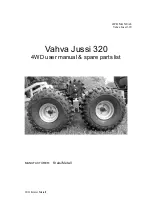
6
SAFE OPERATIONAL PRACTICES
BEFORE OPERATING
Read Operator’s Manuals
Prior to operating the Turf Tender, read and understand
the contents of this Operator’s Manual and the Operator’s
manual of vehicle either towing or carrying the Turf Tender.
Become familiar with all control functions and know how to
turn the vehicle off and stop effectively.
REPLACEMENT MANUAL
A replacement manual is available by sending complete
Model and Serial Number to
Dakota, Inc.
833 Gateway Drive, North East
East Grand Forks, Minnesota 56721
Unauthorized Operators
Never allow children to operate the Turf Tender. Do not
allow anyone to operate the Turf Tender without proper
instruction or training. Only trained and authorized persons
should operate the Turf Tender.
The operator is defined as being the person responsible for
supervising the operation of the Turf Tender and driving the
vehicle that either tows it or carries it.
Drugs And Alcohol
Never operate the Turf Tender when under the influence
of drugs or alcohol.
Shields And Safety Devices
Keep all shields, guards, and safety devices in place. If a
shield, guard, or safety device is damaged, replace or repair it
prior to operating the Turf Tender. If a decal is illegible, order
and install a new one.
Loose Fasteners And Fittings
Although the Turf Tender has been designed so that
components will not come loose during normal operation of
the Turf Tender, always check the Turf Tender prior to start
up and after each use for loose fasteners, fittings, connectors
and other components. Tighten, repair, or replace as necessary.
This includes electrical and hydraulic system components, also.
Only use original
DAKOTA
replacement parts.
Modifications To Turf Tender
Do not modify the Turf Tender in any way. Modifying the
Turf Tender will void the warranty.
Safe Attire
Do not operate the Turf Tender while wearing sandals,
tennis shoes, sneakers, or shorts. Always wear long pants and
substantial shoes. Do not wear loose fitting clothing which
could get caught in control switches or moving parts. The
wearing of safety glasses, safety shoes, hearing protection,
and a hard hat is recommended and may be required by some
ordinances and insurance regulations.
Electronic Controller
Some models (410, 412 and 414) now come with an
elctronic controller. All necessary information for this controller
is located in the back of this manual. If your Turf Tender is so
equipped. refer to the section in the back of the manual as
often as necessary.
WHILE OPERATING
Vehicle Instructions
Mounted-type Turf Tenders are designed to installed on either
the Toro Workman
®
or the John Deere ProGator
®
. Refer to the
Operator’s Manual for capacities, instructions, and precautions.
WARNING
Do not attempt to mount the Turf Tender on a model
other than those listed. Never mount a Turf Tender
on a vehicle that does not have the brakes,
suspension, or frame strength to handle the load.
Trailer-type Turf Tenders can be towed by most utility
tractors with adequate brakes. The tractor pulling 410, 411,
412, and 420 models must have a drawbar hitch capacity to
handle a 7825 lb (3556 Kg) trailer. The tractor pulling 414 and
440 models must have a drawbar hitch capacity to handle a
13,000 lb (5909 Kg) trailer. Refer to your Tractor Operator’s
Manual for towing capacities, instructions, and precautions.
WARNING
Do not attempt to tow a loaded Turf Tender with a
light utility vehicle or runabout. Never tow a Turf
Tender with a vehicle that does not have the brakes,
suspension, or frame strength to handle the load.
When operating a Turf Tender equipped with electric brakes
on hilly terrain, it is recommended to use the Turf Tender’s
brakes in conjunction with the tow vehicle’s brakes. The fully
loaded weight of the Turf Tender may be beyond the capacity
of the just the tow vehicle’s brakes.
Confined Space Operation
Do not run the vehicle’s engine in a confined area without
sufficient ventilation. Exhaust fumes are hazardous and could
possibly be deadly.
Danger Zones
The following danger zones exist in and around the Turf
Tender:
1. A crush hazard exists in any area beneath the Turf Tender.
2. A hydraulic jet puncture hazard and hot oil burn hazard
exists in any area within 6 feet (2 m) of a hydraulic hose
due to the possibility of a puncture in a hose.
3. A projectile hazard exists in any area within a 100 foot
(30 m) radius of the rear and sides of the Turf Tender.
Rocks travel farther than sand during normal top dressing
operations.
4. Entanglement, pinch, and cut hazards exist in any areas
close to rotating and moving components such as
conveyors and spinners.
5. A potential entrapment hazard exists within the hopper.
6. On trailer-type Turf Tenders, a crush hazard exists at the
rear and an impact hazard exists at the front of the Turf
Tender during loading or uncoupling if the load is not evenly
distributed and balanced in front of the wheels due to the
rear tipping down. Never load the Turf Tender when it is
uncoupled from its tow vehicle. Never uncouple the Turf
Tender when there is a load in the hopper. There is potential
of the Turf Tender tipping backwards which could cause
damage to the Turf Tender or injury or even death.
SAFE OPERATIONAL PRACTICES
Содержание TURF TENDER 410
Страница 42: ...42 TROUBLESHOOTING TROUBLESHOOTING ...







































